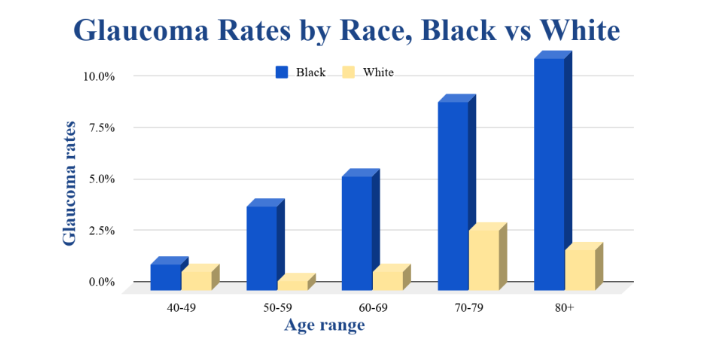Glaucoma, a complex eye condition affecting millions globally, is often dubbed the “silent thief of sight” due to its subtle progression without early symptoms a frequently asked question pertains to whether genetics play a role in the development of alternative traits other than those traditionally considered. In this article, we will delve into the nature of glaucoma, explore its treatment options, and examine the genetic and ethnic factors that contribute to its prevalence.
A Comprehensive Overview of Glaucoma
Glaucoma encompasses a range of eye conditions that lead to optic nerve damage, crucial for transmitting information from the eyes to the brain. The primary open-angle glaucoma, the most prevalent form, occurs when the eye’s fluid, known as aqueous humor, fails to drain adequately.
POAG often progresses slowly and painlessly, and it can result in peripheral vision loss that may go unnoticed until advanced stages. Without intervention, glaucoma can progress to blindness. Timely detection and appropriate management are essential to safeguard one’s vision.
Types of Glaucoma:
- Chronic Open-Angle Glaucoma:
In the case of Primary Open-Angle Glaucoma, which represents about 90% of all glaucoma cases, the drainage angle within the eye remains unblocked. However, over time, the efficiency of the eye’s drainage system, particularly the trabecular meshwork, diminishes. As a result of this, damage occurs to the optic nerve.
- Closed-Angle Glaucoma:
In contrast to Primary Open-Angle Glaucoma, Angle-Closure Glaucoma occurs when there is an obstruction or closure of the drainage angle within the eye. This type of glaucoma can develop suddenly and is associated with a rapid and painful increase in IOP. It necessitates urgent medical intervention.
- Low-Tension Glaucoma:
In Normal-Tension Glaucoma damage to the optic nerve occurs despite the intraocular pressure remaining within the typical range.. This suggests that factors other than elevated IOP contribute to the disease’s development, making it a unique and complex form of glaucoma.
- Acquired Glaucoma:
Secondary glaucoma manifests as a consequence of various eye-related problems or underlying medical conditions such as uveitis (inflammation of the eye), trauma, or diabetes. Treatment for secondary glaucoma typically involves addressing the underlying cause.
Signs of the Disease:
Glaucoma often progresses without obvious symptoms in its early stages, underscoring the significance of routine eye examinations for early detection. As the condition advances, individuals with glaucoma may begin to experience:
- A gradual reduction in peripheral vision, results in the development of “blind spots.”
- Tunnel vision, where the visual field becomes increasingly constricted.
- Halos around lights, particularly at night.
- Eye discomfort, headaches, and nausea are symptoms that can occur in instances of acute angle-closure glaucoma.
It’s important to note that by the time noticeable symptoms occur, significant damage to the optic nerve may have already transpired. This underscores the importance of regular eye check-ups, especially if you have risk factors like a family history of glaucoma, advanced age, or specific ethnic background.
Healthcare Solutions
The management of glaucoma primarily focuses on reducing intraocular pressure to slow or halt the progression of the disease. Treatment alternatives can encompass the following:
- Prescription Drugs:
Eye drops or oral medications can effectively reduce intraocular pressure. These treatments function by either decreasing the production of aqueous humor or enhancing its drainage from the eye.
- Laser Treatment:
Laser techniques such as selective laser trabeculoplasty and laser peripheral iridotomy can be employed to enhance the drainage of fluid from the eye, resulting in a reduction of intraocular pressure.
- Surgery:
Surgical interventions, such as trabeculectomy or glaucoma drainage implants, may be necessary in cases where medications and laser therapy are ineffective. These procedures create new drainage pathways for aqueous humor.
- Behavioral Adjustments:
Certain behavioral adjustments, such as refraining from activities that elevate intraocular pressure and managing other health conditions (e.g., diabetes or hypertension), can also help in managing glaucoma.
It’s crucial to emphasize that the selection of treatment varies based on several factors, which encompass the type and seriousness of glaucoma, the patient’s general well-being, and their capacity to adhere to treatment plans. Glaucoma is a chronic condition that requires lifelong management, and individuals with the condition should work closely with their eye care team to ensure optimal vision preservation.
Is Glaucoma Hereditary?
The hereditary nature of glaucoma has long been a subject of study and debate among researchers. While glaucoma is a multifactorial disease influenced by both genetic and environmental factors, there is evidence to suggest that genetic predisposition plays a significant role in its development.
Numerous genes have been pinpointed as potential factors influencing the risk of developing glaucoma. These genes are associated with various aspects of the disease, such as the regulation of intraocular pressure, optic nerve structure, and retinal ganglion cell function. It’s essential to emphasize that a genetic predisposition does not guarantee the development of glaucoma. It merely increases the risk.
To understand the hereditary factors of glaucoma, researchers have conducted extensive studies, including family-based studies and twin studies. These studies have consistently demonstrated that individuals with a family history of glaucoma face an elevated risk of developing the condition themselves, and this risk is further heightened if a first-degree relative (such as a parent, sibling, or child) has been diagnosed with glaucoma. Here’s a closer look at the hereditary factors associated with glaucoma:
- Family History:
Individuals with a first-degree relative (parent, sibling, or child) who has glaucoma have a higher risk of developing the condition themselves. In instances of primary open-angle glaucoma, the risk is notably higher when there is a family history of the condition.
- Genetic susceptibility:
Numerous genes have been pinpointed as potential factors contributing to the risk of glaucoma. These genes are associated with various aspects of the disease, such as the regulation of intraocular pressure (IOP), optic nerve structure, and retinal ganglion cell function. However, having specific genetic variations doesn’t guarantee that an individual will develop glaucoma—it merely increases the risk.
- Complex Inheritance:
Glaucoma is considered a complex genetic disorder, which means that it involves multiple genes and interactions between genes and environmental factors. The inheritance pattern is not straightforward, making it challenging to predict who will develop glaucoma based solely on family history.
- Ethnic Variations:
The prevalence of glaucoma can vary among different ethnic groups. African Americans have a higher glaucoma risk compared to people of European descent, indicating potential genetic factors at play.
Genetics plays a role in glaucoma susceptibility, but environmental factors and lifestyle choices are also significant contributors. Factors like age, high intraocular pressure, medical conditions (e.g., diabetes, hypertension), and certain medications affect glaucoma risk. Regular eye exams are essential, particularly for individuals with a family history or predisposing risk factors. Early detection allows timely intervention, preserving vision and reducing severe vision loss risk. If concerned about glaucoma risk, consult an eye specialist for personalized guidance.
Hereditary Factors:
Studies have demonstrated that people with a family history of glaucoma face a higher likelihood of developing the condition. The risk is particularly elevated when a first-degree relative (parent, sibling, or child) has glaucoma. While specific genetic factors have been identified, the inheritance pattern of glaucoma is complex, involving multiple genes.
Charts depicting hereditary factors in glaucoma rates might illustrate the following:
- The percentage increase in glaucoma risk for individuals with a family history compared to those without.
- The varying risk levels are associated with different degrees of family relationships (e.g., parent vs. sibling vs. child).
- Genetic markers or mutations associated with an increased risk of glaucoma.
Ethnicity and Glaucoma Rates:
Glaucoma rates can vary significantly among different ethnic groups. Some general trends include:
- African Americans:
Studies have consistently shown that individuals of African descent are at a higher risk of developing glaucoma, particularly primary open-angle glaucoma (POAG). Charts might illustrate the higher prevalence of glaucoma in African-American populations compared to other ethnic groups.
- Hispanic Americans:
Hispanic individuals also have an elevated risk of glaucoma, primarily POAG and normal-tension glaucoma (NTG). Charts could show the prevalence of glaucoma in Hispanic populations compared to other ethnicities. For more information check the following link:
- Asian Americans:
Angle-closure glaucoma is more prevalent among Asian populations. Charts might depict the higher incidence of angle-closure glaucoma in Asian communities compared to other ethnic backgrounds.
- Caucasian Americans:
While Caucasians generally have a lower overall risk of glaucoma compared to other ethnic groups, they are not immune to the disease. Charts could demonstrate the prevalence of glaucoma in Caucasian populations.
- Native Americans and Alaska Natives:
These populations also have an increased risk of glaucoma, particularly angle-closure glaucoma. Charts might display the prevalence of glaucoma in these ethnic groups.
Charts related to ethnicity and glaucoma rates could present data such as:
- Age-specific prevalence rates for different ethnicities.
- The distribution of glaucoma subtypes among various ethnic groups.
- Geographic variations in glaucoma rates within specific ethnic populations.
For detailed charts and scientific articles on these topics, you can explore reputable medical databases like PubMed, consult research conducted by institutions such as the National Eye Institute (NEI), or access the publications of leading glaucoma researchers and ophthalmology journals.
Conclusion:
In summary, glaucoma is a multifaceted condition affected by both genetic and environmental factors, with family history and ethnicity contributing to its risk. To safeguard vision, proactive measures, such as regular eye exams, and close collaboration with eye care specialists, are crucial and essential components of effective glaucoma management. Knowledge and awareness are essential allies in preventing glaucoma, safeguarding your overall eye health, and ensuring a brighter and clearer future.







